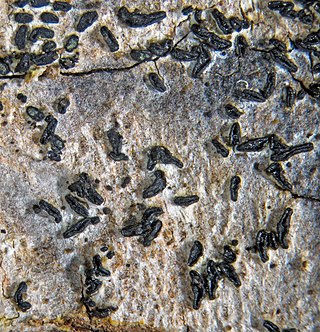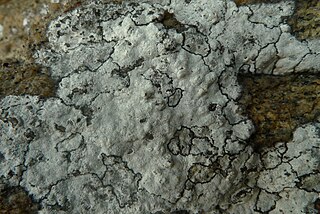
The Arthoniales is the second largest order of mainly crustose lichens, but fruticose lichens are present as well. The order contains around 1500 species, while the largest order with lichenized fungi, the Lecanorales, contains more than 14000 species.

The Arthoniaceae are a family of lichenized, lichenicolous and saprobic fungi in the order Arthoniales. The Arthoniaceae is the largest family of Arthoniales, with around 800 species. Most species in Arthoniaceae belong in Arthonia which is the largest genus with 500 species. The second and third largest genus is Arthothelium with 80 species, and Cryptothecia with 60 species.

The Roccellaceae are a family of fungi in the order Arthoniales, circumscribed by French botanist François Fulgis Chevallier in 1826. This family is distinguished by a wide variety of growth forms, including crustose and fruticose thalli, and a diverse range of reproductive structures. Roccellaceae species typically have apotheciate or lirellate ascomata, often with distinct carbonised (blackened) margins. The family has been extensively studied through molecular phylogenetics, revealing significant genetic diversity and complex evolutionary histories.

Ochrolechia is a genus of crustose lichens in the family Ochrolechiaceae. These lichens typically form uneven, often thick, crust-like growths on various surfaces and are characterised by their white to pale grey thalli, which may have a greenish tint. The genus has a long evolutionary history, with fossils dating back to the Paleogene period, about 34 million years ago. Ochrolechia species have disc-like apothecia, which are usually yellowish or brownish-pink and often covered with a fine white powdery coating. The genus is widely distributed and includes both common and rare species, with some found in extreme environments such as arctic and alpine regions. Ochrolechia lichens produce diverse secondary metabolites, including orcinol depsides, depsidones, and xanthones.

Roccella is a genus of 23 species of lichens in the family Roccellaceae. The genus was circumscribed by Swiss botanist Augustin Pyramus de Candolle in 1805, with Roccella fuciformis as the type species.

Alyxoria is a genus of lichen-forming fungi in the family Lecanographaceae.

Lecanographaceae is a family of mostly lichens in the order Arthoniales. The family was circumscribed in 2014, prompted by a molecular phylogenetic-based restructuring of the Arthoniales.

Roccellographaceae is a family of lichen-forming fungi in the order Arthoniales. It contains three genera: Dimidiographa, Fulvophyton, and Roccellographa.
Baidera is a single-species fungal genus in the family Roccellaceae. It contains the species Baidera mauritiana, a corticolous (bark-dwelling), crustose lichen found in Mauritius. Both the genus and species were described as new to science in 2020 by Paul Diederich and Damien Ernst. The genus name honours Cláudia Baider, curator of the Mauritius Herbarium.
Vigneronia is a genus of lichen-forming fungi in the family Roccellaceae. It has five species. The genus was circumscribed in 2014 by Damien Ernst, with Vigneronia spieri assigned as the type species. This species, originally described as Schismatomma spieri from collections made in the Galápagos Islands, has since been recorded from mainland Ecuador and the Antilles (Curaçao). The genus is named after Ernst's wife, Nathalie Vigneron, who accompanied him on collecting trips.
Gyrographa is a genus of lichen-forming fungi in the family Roccellaceae. The genus was circumscribed in 2014 by Damien Ernst and Anders Tehler, with Gyrographa gyrocarpa assigned as the type species. This lichen, originally described by Julius von Flotow in 1825, was first placed in the genus Opegrapha. Species in the genus have a crustose thallus lacking a cortex, and a dark brown prothallus. The photobiont partner is trentepholioid. The hypothecium is thick and carbonised, and the ascospores lack a gelatinous sheath; these characteristics distinguish it from Opegrapha species. The genus name alludes to the gyrose ascomata of the type species.
Isalonactis is a monotypic fungal genus in the family Roccellaceae. It contains the single species Isalonactis madagascariensis, a saxicolous (rock-dwelling), crustose lichen found in Madagascar. Both the genus and species were described as new in 2014 by Damien Ertz, Anders Tehler, Eberhard Fischer, Dorothee Killmann, Tahina Razafindrahaja, and Emmanuël Sérusiaux. The type was collected on the Isalo Massif at an altitude of 851 m (2,792 ft); there, it was found growing on sheltered mesozoic sandstone cliffs. The genus name alludes to both Isalo Massif, the type locality, and the phylogenetic relatedness to genus Lecanactis.
Ocellomma is a genus of lichen-forming fungi in the family Roccellaceae. The genus was circumscribed in 2014 by Damien Ertz and Anders Tehler, following a molecular phylogenetic-based revision of the Roccellaceae. The type species, O. picconianum, was originally named Lecania picconiana by Francesco Baglietto in 1862, described from specimens collected in Italy. DNA-based phylogenetic analysis showed that it occupied a distinct genetic lineage, deserving of recognition as a new genus. The genus name Ocellomma alludes to the whitish rims on the small ascomata that contrast with the discs, giving them the appearance of small eyes.
Dirina arabica is a species of saxicolous (rock-dwelling), crustose lichen in the family Roccellaceae. Found in Socotra, it was formally described as a new species in 2013 by lichenologists Anders Tehler and Damien Ernst. The type specimen was collected by the first author near the village in Homill, at an altitude of 350 m (1,150 ft). The species epithet refers to Arabia, the geographical location encompassing the type locality. The lichen is endemic to Socotra, where it grows on Eocene limestone rocks. It has a creamy-white, slightly pruinose thallus that is 0.1–0.5 mm thick and a chalk-like medulla. There are no soralia on the thallus. The ascomata have a circular outline and measure up to 2.0 mm in diameter, and have a pruinose, white-grey disc with a thalline margin. Dirina arabica is a sister species to Dirina immersa, a sympatric species that can be distinguished from the former by its immersed ascomata.
Dirina monothalamia is a species of corticolous (bark-dwelling) in the family Roccellaceae. It occurs in Cape Verde and the nearby mainland of Senegal, where it is found in coastal outcrops on the bark of various trees; Senegalese populations are often on the bark of African baobab.
Ostropomyces is a genus of fungi in the family Stictidaceae. It has two species, both of which are found in tropical forests in northern Thailand, where they grow as saprotrophs on bark.
Dimidiographa is a genus of lichen-forming fungi in the family Roccellographaceae. It has three species of crustose lichens, with Dimidiographa loandensis serving as the type species.

Fulvophyton is a genus of lichen-forming fungi in the family Roccellographaceae. It has 11 species. Fulvophyton is characterised by its crust-like thallus, which is often pale yellowish-brown in colour. This genus features a photobiont from the green algal genus Trentepohlia and exhibits a unique arrangement of reproductive structures.
Neosergipea septoconidiata is a species of corticolous (bark-dwelling) lichen in the family Roccellaceae. It is a unique species of lichen that grows on the bark of trees in the primary forests of Brazil with its bluish-grey thallus and bright orange pycnidia that have a fluffy hyphal surface.
Melanotopelia is a genus of lichen-forming fungi in the family Graphidaceae. It has four species of corticolous (bark-dwelling), crustose lichens. This genus includes species characterised by dark pigmentation in their exciple, non-amyloid ascospores, and specific secondary metabolites.








